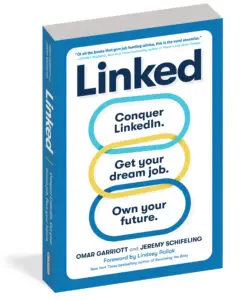Many job seekers struggle to know what type of work to look for in the first place. For a searcher who’s still in the process of exploring, here is a way to proceed.
LinkedIn now offers AI assistance with its skills-based “Career Explorer” tool. The tool is new and not readily available on LinkedIn, so you may need to do some searching first on the platform.
Try the “career explorer” mode
In a nutshell, Career Explorer allows you to explore which types of positions might be a good fit based on the jobs (and skills needed for them) you’ve already had. Then, you can search for new positions based on those skills, not just by job title or location (as is the case on most job boards).

Career Explorer uncovers the overlap between skills typically required for what may seem like very different jobs. For instance, let’s say you’re a Project Manager in Atlanta who’s sick of being stuck in the office all day. Is there some way that your existing skills could lead you to a new job that’s a better fit?
Well, by matching the skills you already have with those across thousands of other professions, Career Explorer can help you find roles you didn’t even realize were related, like Construction Manager. The tool will give you a percentage match between roles, as well as other data showing levels of skill overlap and how popular the transition has been for other workers.
In addition, it outlines the skills you need to build so that you can fully cross the chasm, including LinkedIn Learning courses you can take to close the gap. Plus, in the spirit of fully exploring careers by learning from insiders, it makes it easy to find connections on LinkedIn who can help you kick the tires on this potential role.
For the job seeker looking for advice on positioning yourself, here are a few suggestions.
Frame your active candidacy
Recruiters typically segment candidates into two main categories: active and passive. Active job seekers are more urgently looking for a new job, while passive ones are employed but open to new opportunities. Passive candidates include “tiptoers” on one end of the continuum (those who are thinking about making a move but aren’t yet applying) and “super-passive” candidates on the other end (those who wouldn’t consider anything short of the world’s greatest opportunity).
So why do these categories matter to an active job seeker? Well, it means you’re not only competing with other active applicants. In fact, research shows that the majority of “candidates” (roughly 73%) are passive job seekers.
More consequentially, many recruiters and hiring managers view these passive candidates as highly qualified and desirable—especially for more senior roles. There are a few reasons why.
Passive candidates are usually employed by a competitor or other known entity in the space. They’ve passed through any number of LinkedIn Recruiter filters, so their keywords and experience are likely quite strong. And they’re often connected to people on the inside (i.e., an employee thought of them and is trying to “sell” them on applying for the job).
Given that there are recruiters out there who value passive candidates more than active ones, you should be thoughtful about how to broadcast that you’re on the market. For instance, we definitely don’t recommend wasting valuable characters in your LinkedIn Headline saying that you’re searching. Not only can it be off-putting, but those characters are better used to focus on the keywords that recruiters do search, like your desired job title. The job seekers we work with, especially those with more previous work experience, get the best results by toeing the line: appearing to be a passive candidate even if they’re actively seeking a new role.
That said, a more spray-and-pray strategy like adding the “#OpenToWork” photo frame can be valuable at specific moments. One time is just before expanding your 1st-degree connections with the Contact Import tool. Those hundreds of new people you’re adding will see you’re #OpenToWork when they inevitably check out your profile to see what you’ve been up to—it may very well pay dividends.
Another time is when you’ve written an awesome original article. As it gets distributed throughout LinkedIn, a hiring manager could think not just, “Wow, this author is impressive” but also, “. . . and I might even be able to hire them!”
Show, don’t tell, with posting
Posting an article on LinkedIn—strategically, not indiscriminately—can be gold. In the platform’s efforts to be sticky and social, however, parsing what matters from what doesn’t sometimes gets confusing. There are all sorts of posts, like status updates, pictures and videos, events, notices for work anniversaries or new jobs, endorsements for others, and original long(er)-form content—but one of these things is not like the other (hint: It’s that last one).
Writing and posting articles is sort of like blogging, only with a built-in platform for distribution (i.e., your connections and connections of connections—so, probably better than a traditional blogging site like Medium). This is the only social media share that actually matters for job seekers on LinkedIn. Why? Because it’s an opportunity to show that you have an original thought and can think critically, as opposed to merely resharing someone else’s posts—which might help them get hired, but is less useful to you.
Your written posts are attached to your profile and remain viewable for anyone who’s skimming it, including prospective employers or connections. This is especially valuable for career switchers— you’re putting yourself out there for the industry or function you want to be in, and demonstrating skill and competency even without the relevant job experience.
Aim for 500 to 750 words and add an image to entice clicks. Consider including prompts for readers (like responding to a key industry- or company-specific challenge), reacting to a recent news story or op-ed, or offering key takeaways from an event you attended. Make yourself a thought leader.
Here are some examples, based on different industries and career levels:
- Nonprofits: “7 Ways to Increase Donor Engagement”
- Manufacturing: “What Will Supply Chain Management Look Like in 10 Years?”
- Tech: “How I Helped My Start-Up Raise Its First Seed Round”
- Consulting: “How Majoring in English Prepared Me to Be a Consultant”
Tricks for job seekers
Humans share fundamental traits that you can tap into to really level up your job-seeking game. Let’s look at a handful of those traits.
- Reciprocity: We’re wired to support people we trust. You can foster this expectation when providing informational interviews or making referrals or introductions. When someone thanks you for helping them out, don’t cheapen your effort with something like, “No problem” or “No big deal.” Instead, say, “You would do the same for me!”
- Social proof: Most of us don’t really know what we want. This is exacerbated by “choice overload,” the reality that people can’t handle the many choices they think they want. So what do we do? We wait to see the outcomes of our peers’ choices before making our own. That means when you reach out to a new contact, be sure to reference your mutual connections (e.g., “So great to meet a friend of Chanelle’s!”) Even if the mutual contact is fairly new to you, their existing relationship will grease the wheels of your conversation (“Well, seeing as you’re friends with Chanelle, too, I’d love to chat!”).
- Sense of urgency: We’re all procrastinators. We take a ton of mental shortcuts every single day to ease our cognitive load. For example, when that interesting-but-not-pressing connection request comes through, we decide not to prioritize it in the moment—and often we never come back around to it. Instead, create urgency, even if it’s a bit artificial, when you need a response or a serious look at your application. Make it seem like time is running out on your candidacy or interest in connecting.
- Lower the “activation energy”: This term, borrowed from chemistry, describes the effort required to get something done. Lowering activation energy is a key part of creating new habits (e.g., if you want to run first thing in the morning, sleep in your favorite running clothes). As a job seeker, you want to make it as easy as possible for the person on the other side—a desired connection or referrer, an interviewer or an applicant-screener—to say “yes.” Spend time thinking about the quickest way to move them along the decision journey and reduce their cognitive load. Little things like having your email address right on your profile (in the About section) or starting off your interview with a line like, “I know I’m perfect for this role” can sometimes be all that’s required.
Excerpted from Linked: Conquer LinkedIn. Get Your Dream Job. Own Your Future. (Workman Publishing) by Omar Garriott and Jeremy Schifeling. Copyright © 2022.
Omar Garriott and Jeremy Schifeling are the cofounders of the Job InSiders, a comprehensive program that advises students and professionals on the modern job search. The pair joined forces while launching and leading marketing of LinkedIn’s education team. Their mission is to demystify LinkedIn for every job seeker on Earth, from career starters to career climbers.
Recognize your brand’s excellence by applying to this year’s Brands That Matter Awards before the early-rate deadline, May 3.
